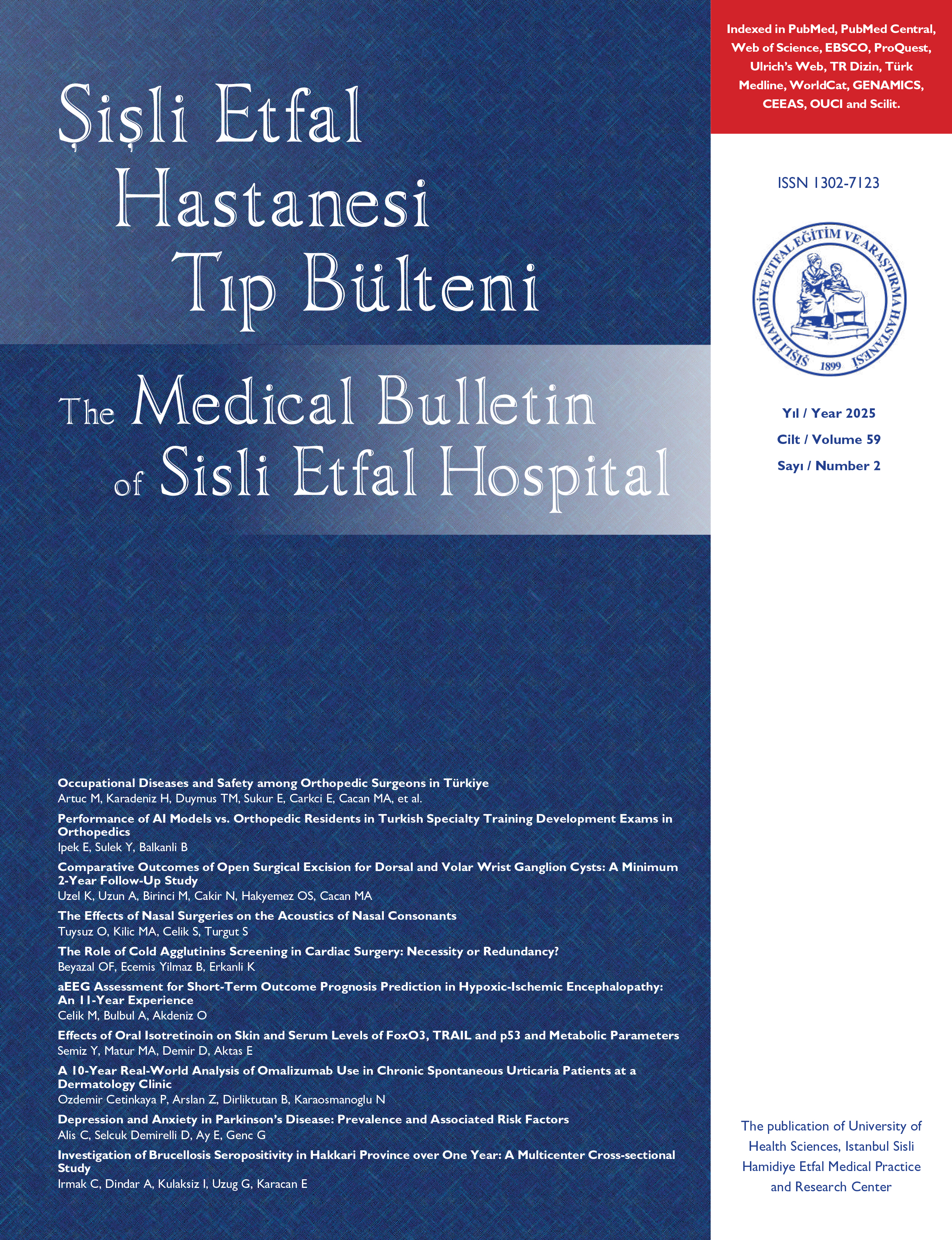
Papiller Tiroid Kanserinin Cerrahi Tedavisinde Tamamlayıcı Tiroidektomi ve Total Tiroidektominin Hipokalsemi Riskinin Karşılaştırılması
Mehmet Taner Unlu, Mehmet Kostek, Ozan Caliskan, Nurcihan Aygun, Mehmet UludagTürkiye Sağlık Bilimleri Üniversitesi, Şişli Hamidiye Etfal Eğitim ve Araştırma Hastanesi, Genel Cerrahi Anabilim Dalı, İstanbulGİRİŞ: Papiller tiroid kanseri en sık görülen tiroid kanseridir. Bazı hastalarda lobektomi yapıldıktan sonra histopatolojik incelemede saptanan papiller tiroid kanserinin histopatolojik özellikleri nedeniyle karşı loba tamamlayıcı tiroidektomi gerekebilir. Hipokalsemi tiroidektomi sonrası en sık görülen komplikasyon olup, etyolojisi multifaktöryeldir. Tamamlayıcı tiroidektominin hipokalsemi gelişme riskini arttırıp arttırmadığı halen tartışma konusudur. Bu çalışmada papiller tiroid kanseri tanısı ile tamamlayıcı tiroidektomi uygulamasının total tiroidektomiye göre hipokalsemi riskini arttırıp artırmadığını değerlendirmeyi amaçladık.
Gereç ve Yöntem: 2015-2018 tarihleri arasında opere edilen, preoperatif veya postoperatif dönemde papiller tiroid kanseri tanısı alan hastaların verileri retrospektif değerlendirilerek 2 hasta grubu oluşturuldu. Grup 1e ilk ameliyatta lobektomi yapıldıktan sonra patolojik incelemede papiller tiroid kanseri saptanan ve karşı loba tamamlayıcı tiroidektomi uygulanan 19 hasta alındı. Grup 2ye aynı dönemde total tiroidektomi uygulanan preoperatif veya postoperatif papiller tiroid kanseri tanısı koyulan hastalar arasından yaş ve cinsiyet olarak 1. gruba benzer özelliklerde 53 hasta seçildi. İki grup arasında preoperatif ve postoperatif dönemde kalsiyum metabolizması ile ilgili biyokimyasal parametreler, paratiroid ototransplantasyonu ve istenmeden paratiroid bezi çıkarılması, postoperatif hipokalsemi ve tedavi oranları karşılaştırıldı.
Bulgular: Grup 1de ve 2de sırası ile, yaş ortalaması 48.3+12.1 olan 19 hasta (13K, 6E), 46.3+9 (40K, 13E) olan 53 hasta yer almakta olup; yaş ve cinsiyet açısından gruplar arasında anlamlı fark yoktu. Preoperatif parathormon (PTH), fosfor (P), magnezyum (Mg), D vitamin eksikliği oranı, paratiroid ototransplantasyonu ve tiroid piyesinde paratiroid bezi bulunması açısından anlamlı fark saptanmadı. Preoperatif kalsiyum (Ca) değeri 1. grupta 9.33+0.46 olup, 2. Gruba (9.65+0.41) göre düşüktü (p=0,012). Postoperatif 0. Gün Ca, P, Mg, PTH; 1. gün Ca, Mg, PTH; değerleri arasında anlamlı fark yoktu. Postoperatif 1. Gün P düzeyi 1. grupta (2.86+0.72) 2. gruba (3.6+0.83) göre anlamlı olarak düşüktü. Postoperatif hipkalsemi oranları grup 1 ve 2de sırası ile %21.1, %30.2 olup fark anlamlı değildi (p=0,558). Her iki gruptada hipokalsemiler geçici olup, kalıcı hipoparatiroidi saptanmadı. Grup 1 ve 2de sırası ile paratiroid ototransplantasyonu (10.5% vs 3.8%; p=0,283), piyeste aksidental çıkarılan paratiroid oranı(0 vs 15.1; p=0,185) benzerdi.Postoperatif dönemde Ca ve bazen aktif D vitamin uygulanması oranı grup1de %10.5, grup 2de %22.6 olup, tedavi alma açısından gruplar arasında anlamlı fark yoktu (p=0,327).
Sonuç: Postoperatif histopatolojik olarak papiller tiroid kanseri tanısı alan bazı hastalarda tamamlayıcı tiroidektomi gerekli olabilir. Tamamlayıı tiroidektomi prosedürü, total tiroidektomiye göre hipokalsemi riskini artırmadan uygulanabilir. (SETB-2022-10-219)
Does the Risk of Hypocalcemia Increase in Complementary Thyroidectomy Performed in Papillary Thyroid Cancer?
Mehmet Taner Unlu, Mehmet Kostek, Ozan Caliskan, Nurcihan Aygun, Mehmet UludagDivision of Endocrine Surgery, Department of General Surgery, University of Health Sciences Türkiye, Sisli Hamidiye Etfal Training and Research Hospital, Istanbul, TürkiyeObjectives: Papillary thyroid cancer (PTC) is the most common type of thyroid cancers. In some patients, due to the histopathological features of PTC, complementary thyroidectomy (CT) may be needed to contralateral thyroid lobe after lobectomy. Hypocalcemia is the most common complication after thyroidectomy and its etiology is multifactorial. It is still controversial whether the CT increases the risk of hypocalcemia or not. In this study, we aimed to evaluate whether CT procedure increases the risk of hypocalcemia compared to total thyroidectomy (TT) in PTC patients.
Methods: The data of the patients who were operated between 2015 and 2018 and diagnosed with PTC in the pre-operative or post-operative period were evaluated retrospectively, and two patient groups were formed. Group 1 included 19 patients who were diagnosed with PTC in the pathological examination after lobectomy was performed in the first operation, and after that CT was performed to the contralateral lobe. Among the patients who were diagnosed with pre-operative or post-operative PTC in the same period, 53 patients with characteristics similar to the 1st group in terms of age and gender were selected for Group 2. Biochemical parameters related to calcium metabolism in the pre-operative and post-operative periods, parathyroid autotransplantation and unintentional parathyroid gland removal, post-operative hypocalcemia, and treatment rates were compared between the two groups.
Results: There were 19 patients (13 F and 6 M) with a mean age of 48.3±12.1 years and 53 patients with a mean age of 46.3±9 (40 F and 13 M) in Groups 1 and 2, respectively, and there was no significant difference between the groups in terms of age and gender. There was no significant difference in terms of pre-operative parathormone (PTH), phosphorus (P), magnesium (Mg), Vitamin D deficiency rate, parathyroid autotransplantation, and presence of parathyroid gland in thyroid specimen. Pre-operative calcium (Ca) value was 9.33±0.46 in Group 1 and lower than Group 2 (9.65±0.41) (p=0.012). There was no significant difference between the groups in terms of post-operative day 0 Ca, P, Mg, and PTH and post-operative day 1 Ca, Mg, and PTH. Post-operative day 1 P level was significantly lower in Group 1 (2.86±0.72) compared to Group 2 (3.6±0.83). Post-operative hypocalcemia rates were 21.1% and 30.2% in Groups 1 and 2, respectively, and the difference was not significant (p=0.558). In both groups, hypocalcemia was transient and permanent hypoparathyroidism was not detected. Parathyroid autotransplantation rates (10.5% vs. 3.8%; p=0.283) and the rate of unintentionally removed parathyroid gland (0 vs. 15.1; p=0.185) were similar in Groups 1 and 2, respectively. Ca and active Vitamin D administration rates in the post-operative period were similar in Group 1 and Group 2 (10.5% vs. 22.6%; respectively), and there was no significant difference between the groups in terms of receiving treatment (p=0.327).
Conclusion: CT can be necessary in some patients with post-operative diagnose of PTC. CT can be performed without increased risk of hypocalcemia compared to TT.
Makale Dili: İngilizce



















